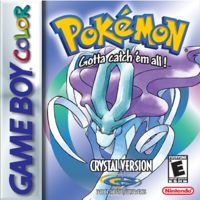Difference between revisions of "Pokémon: Crystal Version"
WarioFan63 (talk | contribs) |
m (→Story) |
||
| Line 16: | Line 16: | ||
=Story= | =Story= | ||
| − | Taking place after the events of the [[Pokémon: Red, Green and Blue Versions|original set of games]], ''Pokémon Gold and Silver'' | + | Taking place three years after the events of the [[Pokémon: Red, Green and Blue Versions|original set of games]], ''Pokémon Crystal'' (like ''Gold'' and ''Silver'') follows the journey of the new character, [[Gold]] (Gold is the default; the player may name him anything). Like [[Red]], Gold wants to become a Pokémon master. To accomplish this, Gold must defeat eight Pokémon gym leaders; defeat the [[Elite Four]]; compete with his rival, [[Silver]]; foil the plans of [[Team Rocket]]; and capture as many of the different species of Pokémon as he can. |
=Gameplay= | =Gameplay= | ||
Revision as of 18:13, 20 February 2010

| |
| Pokémon: Crystal Version | |
| Developer | Game Freak |
| Publisher | Nintendo |
| System | Gameboy Color |
| Release Date | JP December 14, 2000 US July 29, 2001 AU September 2001 EU November 2, 2001 |
| Rating | ESRB: E |
Pokémon: Crystal Version is the third and final version of the second generation Pokémon games, following Pokémon: Gold and Silver Versions. Like Pokémon: Yellow Version, it has a somewhat altered storyline, along with new features not present in Gold or Silver.
Story
Taking place three years after the events of the original set of games, Pokémon Crystal (like Gold and Silver) follows the journey of the new character, Gold (Gold is the default; the player may name him anything). Like Red, Gold wants to become a Pokémon master. To accomplish this, Gold must defeat eight Pokémon gym leaders; defeat the Elite Four; compete with his rival, Silver; foil the plans of Team Rocket; and capture as many of the different species of Pokémon as he can.
Gameplay
Pokémon Crystal reprises the gameplay and connections of the previous versions, except with several new alterations shown below.
Connectivity
While Crystals connectivity is the same as Gold and Silver in the American version, there was on feature only in Japan; this was was a mobile phone link-up which could be used to link up with other players over mobile phone connections. Through this the player could also obtain the GS Ball, which was needed to obtain Celebi. However, this feature was removed from releases of the games in other countries due to Nintendo's opinion cell phones not being as popular among children in other countries as they were in Japan.
Version Differences
As with the main difference between Gold and Silver, there are several varieties of Pokémon that cannot be found in Crystal and must be traded from one of the other games.
One of the main new features of Crystal is the option to choose your trainer's gender. In addition, there are a few storyline differences; as Gold had focused on Ho-Oh and Silver and Lugia, Crystal focuses on the legendary dog Suicune. A new subplot involves a new character, Eusine, who hunts for Suicune. Graphically, the Pokémon battle sprites were now animated. Other additions included the addition of Move Tutors and the Battle Tower.
Legacy
Most of the new features in Crystal were implemented into the later Pokémon games.
Sequels
The next mainstream games to be released were Pokémon: Ruby and Sapphire Versions.
Remakes and Rereleases
The second generation games were remade for the Nintendo DS as Pokémon: HeartGold and SoulSilver Versions. This version included Eusine's storyline and a similar Suicune hunt.